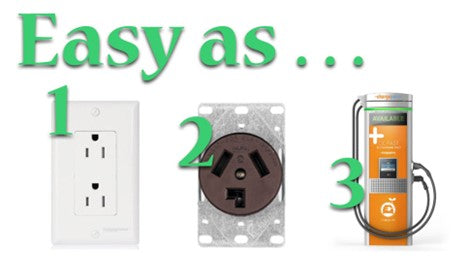
EV Charging Types Explained
EV Charging Types Explained – Simply!
EV Charging Types Explained – for Home Charging.
If you’re new to the world of electric vehicles—welcome! You’ve arrived at just the right time. There are three key EV charging types. In this article we will look at each of them..
In 2020, there’s a great range of EVs from many of the world’s top car manufacturers, all available now in the US. While the Tesla brand name has garnered much attention over the last few years, there are also great new EVs from motoring industry leaders. Manufacturers such as Chevy, Nissan, Hyundai and Kia, make very practical EVs that can pretty seamlessly replace your gas-powered car right now.
Advancements in EV battery technology and vehicle performance mean the biggest difference between your internal-combustion car and an EV is pretty much down to how to ‘fill her up’. This article will explain—simply—how to do just that! The EV world has established three distinct charging ‘levels’, all of which have their pros and cons, so that’s a good place to start.
Level 1 Charging
Level 1 charging can be used for all pure EVs (battery only) and Plug-in Hybrid Vehicles (PIHV; battery and gas engine). The EV manufacturer provides a cable that enables the car to be directly connected to any standard wall socket. Most likely, you have a spare socket conveniently located in your garage. This standard socket has the technical name of NEMA 5-15 receptacle. This style of plug interface is designed for use with the common 120v US wiring found in almost every home, up to a current draw of 15 Amps.
Benefits of Level 1 Charging
- Every EV and PIHV can use it
- Nothing extra to install
- No additional money to spend
Unfortunately, there are also some serious drawbacks with Level 1 charging. As EVs have developed, the driving public has demanded greater range from their electric cars—range approaching that of gas fueled cars. And EV manufacturers have delivered! Cars that can travel up to 300 miles on a full charge are now readily available. This significant increase in range is achieved using larger batteries with higher charge-density. The problem, of course, is that the greater battery capacity means they take longer to charge.
Although there’s much discussion about the availability of ‘public charging’ facilities, the reality is that over 80% of charging is done at home; therefore, the speed of home charging is a very important aspect of the whole equation.The typical scenario is that an EV owner plugs in their car after returning home from work. The car then charges for the entire night and is ready to go for the work commute the next morning. Level 1 charging worked fine when EVs had smaller batteries and could be fully recharged (even from empty) overnight.
However, with a 2019 EV, such at the Tesla Model 3 or a Chevy Bolt, empty-to-full charge times from a Level 1 charger can run to 40 hours or more. So, for most EV owners today, Level 1 charging is great to have as a backup, but is unlikely to enhance the experience of ownership if it’s the sole method of charging.
Level 2 Charging – The Key EV Charging Type!
Level 2 charging uses 240v power and (typically) around 16 to 30 Amps to get the job done. With this method, a Tesla Model 3 can be charged from empty to full in 6 to 8 hours. The time variation reflects differences between chargers and the electrical interfaces that can be used for Level 2 chargers.
The first thing to understand is that to use Level 2 charging at home, you will have to spend at least some money! This can vary from a modest outlay (say, $200) to significantly more (say, $2000), depending on the type of charger you decide to purchase. The two key types of Level 2 chargers are ‘hardwired’ and ‘plug-in’.
Hardwired Level 2 Chargers
Hardwired Level 2 chargers need to be installed by an electrician. They use 240v power and connect directly back to the main power panel in your house, using cable that runs through the walls. This can be an expensive undertaking in many areas of the US. Depending on the home modifications, you may need to seek planning approval and possibly upgrade the power panel itself. Most hardwired Level 2 chargers draw between 32 Amps and 50 Amps of current. This can have a marked impact on a standard electrical panel rated at 100 Amps, and which also needs to deliver power for the entire house!
The advantage of these high-powered chargers is that they can charge a modern EV from full to empty in 6 to 8 hours. The disadvantage is that they can be expensive to purchase and install. A typical hardwired Level 2 charger will cost around $600 to purchase, while installation costs can vary widely. A simple installation will typically cost $500 to $1000, if implemented by a licensed electrician. Also keep in mind: if you move house, your hardwired charger will be staying behind!
Plug-In Level 2 Chargers
But there is good news! There’s a much lower cost way to get access to Level 2 fast charging for your EV: ‘plug-in’ Level-2 chargers. Fortunately, many US homes already have a 240v socket in the garage that can be used for this purpose. The most common format is the ‘dryer-socket’ used to connect 240v electric clothes dryers. This interface is technically called a NEMA 10-30, and can be used with plug-in chargers that draw up to 30 Amps. There are a number of important advantages of this system: lower purchase price (about $200), no installation cost, and a much faster charging time.
Benefits of Plug-in Level 2 Chargers
- Cheaper to buy—typically around $200
- No installation cost or inconvenience
- Fast charging—8-10 hours for a modern EV
With access to this type of interface and a plug-in Level 2 charger, you can simply plug in your EV when you get home from work, and be assured of a full charge the next morning. Plug-in Level-2 chargers are a great way to get fast charging at home—without the hassle of electricians and expensive hardwired chargers.
Level 3 Charging

Level 3 charging—also known as DC Charging—is only really available at public charging stations. These stations can charge a modern EV to 80% capacity in about 30 to 60 minutes. They are becoming more common and are often available at supermarkets or public car parks.
Not all EVs can support this form of charging, however, and the ones that do require different interfaces to access it. Tesla, for example, have a proprietary Level 3 plug interface. There are also industry standard interfaces, such as CHAdeMO. Most public charging facilities also support the standard J1772 plug for Level 2 charging, an interface that can be used by every EV.
Public charging for EVs is certainly a key contributor to EV adoption and market development; however, it’s important to remember that the vast majority of EV charging takes place at home!
Key Points
To really enjoy your new EV, it’s important you’re able to charge it quickly and conveniently. Ultimately, that means you will need to implement Level-2 fast charging in your home. The painless way to achieve this, is to use a plug-in charger and connect to power using the existing 240v ‘dryer-plug’ in your home. In doing so, you can charge quickly without the risks and increased costs of having an electrician install a hardwired system you may eventually have to leave behind you!






